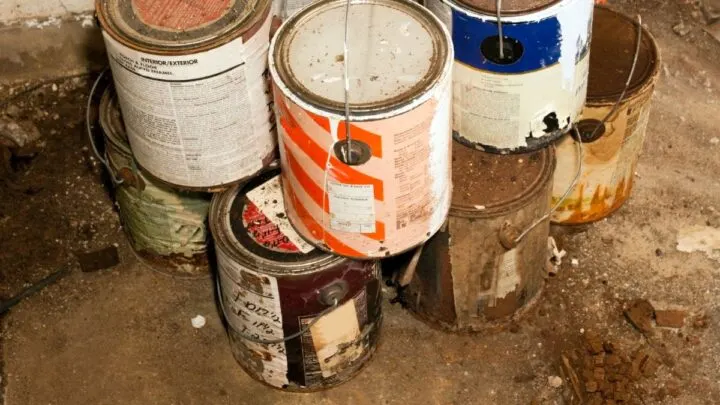Are you planning to transform your eyesore cabinets into eye-catching ones?
Then you probably have come around to the idea of painting your laminate cabinets but are unsure if you can do actually paint over laminate. Then allow us to walk you through it.
Laminate cabinets are typical in older homes and need to be updated. You can easily do this by painting them.
You can paint laminate cabinets, as long as you take the proper preparatory steps first. This includes sanding and priming the laminate surface.
You will probably be happier with the results if you view the paint job as a temporary fix until or unless you can invest in the new cabinetry.
Fret not! We have prepared a list of dos and don’ts that will help you paint your laminate cabinets to give them a finished look.
However, before starting, you must make the necessary repairs, sand the surface, and clean the area.
Let’s take a look at how you can paint and prime your laminate cabinets.

Steps to Paint a Laminate Cabinet
With some extra effort and the proper preparation, you can completely change the appearance of your boring laminate cabinets.
To get this done quickly, read the below-mentioned guide.
Step 1: Prepare the Cabinet Surface
Preparation is the secret to having the best paint results. Remove the laminate cabinet doors from the frames, then remove all hinges and hardware.
You would not want to paint over damage, so look for cracks or warps in the laminate and fix them. Finally, give the doors a light sanding and cleaning.
To ensure that the doors are dust-free, use a tack cloth.
Step 2: Prime Doors and Cabinets
Once you are done with preparing the surface, it’s time to prime them. You should use a top-notch primer while doing this.
Use a good-quality paintbrush to reduce stroke marks when cutting along cabinet edges or tight spaces.
You can also use a roller for the doors and any other big surfaces to achieve a finish that is smooth and free of brush strokes.
Step 3: Re-Sand the Laminate Surfaces
After the primer has completely dried, lightly sand everything once more.
To smooth the surface, use fine-grit sandpaper, but do not sand it too much.
Not all of the primer you recently applied should be removed. Afterward, use a tack cloth to remove the dust.
Step 4: Start Painting The Laminate Cabinets
It’s finally time to add the paint. Select a paint that is made to be used on laminate surfaces.
It has a rugged, chip-resistant finish, is simple to clean with mild liquid soap, and dries to the touch in an hour.
It is also advised to use a satin finish because it will cover up any minor flaws.
What Are The Dos And Don’ts of Painting Laminate Cabinets?
Now you know the steps for painting your laminate cabinets; here are some do’s and don’ts you must remember.
Dos of Painting Laminate Cabinets
- Remove The Cabinet Hardware
Remove pulls, knobs, and other noticeable cabinet hardware before painting laminate cabinets for a clean, obstruction-free paint application.
If the hinges are detachable, you can remove the cabinets’ doors and paint each separately on a sawhorse or a workbench while masking the steel on the hinges with painter’s tape.
- Make Sure to Sand The Cabinets
You’ll need a gritty partner to do this. Use sandpaper to rough up the smooth laminate to establish a close connection between your cabinet and the paint.
Consider upgrading to an electrical sander for better coverage of a greater surface area.
Thoroughly dust the cabinet surfaces with 120-grit sandpaper. Also, be careful not to rip off the paper-thin laminate surface.
Then, remove any remaining dust with a damp cloth or handheld vacuum.
- Test Your Paint Before Applying
With paint in hand, you’re almost prepared to begin. But first, make sure your stock is appropriate for the task at hand.
Before starting an entire paint job, you should test the material’s bonding abilities to prevent future paint peeling and the need to repaint.
Apply your paint to a discreet, small area of your cabinet and allow it to dry, and then check the bonding.
If the coat has some bubbles it is not adhering correctly, speak with a paint salesperson to find a paint that is better suited for the job.
Dont’s of Painting Laminate Cabinets
- Don’t Paint or Coat Over Damaged Laminate
Damage to the laminate, such as cracks, peeling, or warps, can prevent paint from adhering to the cabinet properly.
Before painting, make sure the laminate is in decent form by fixing minor laminate damage or refacing cabinets.
- Don’t Leave Dirt and Grit Behind
It may be alluring to inspect your cabinets and determine that any stains are insignificant enough to be covered with paint.
Still, if the color doesn’t stick to the laminate well, the laminate will show through and reveal your dirty little secret.
Use trisodium phosphate to gently wipe away any accumulated grime and grease before you begin painting laminate cabinets.
After that, rinse with new water and completely dry the cabinets.

- Never Use Old Paint or Primer
Only those primers and paints made specifically for laminate’s finicky surface work well with it.
If you decide to use a primer, pick a bonding primer that is strong enough to adhere to laminate. Once the primer has dried, you can paint over it with latex or oil-based paint.
You can skip the primer if you choose a paint that could be directly applied over laminate but be aware that this requirement may restrict the colors you can use.
Final Words on Painting Laminate Cabinets
You can paint your laminate cabinets to give them a new look, but remember that DIY painted finishes will be more prone to damage than cabinetry with a factory finish.
This means you might eventually need to spend money replacing all of your cabinets. You can buy some time and give laminate cabinets an updated appearance by painting them.


